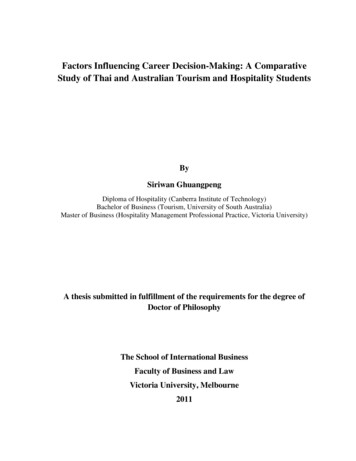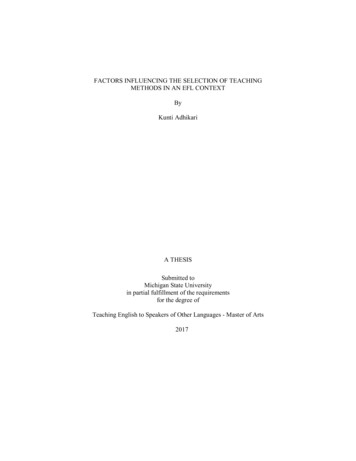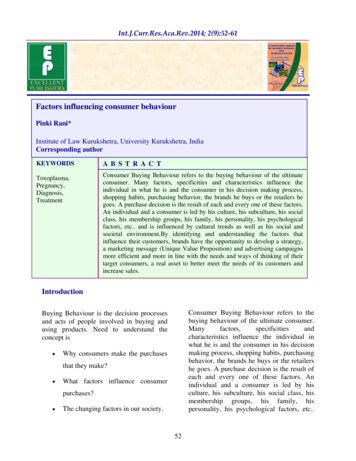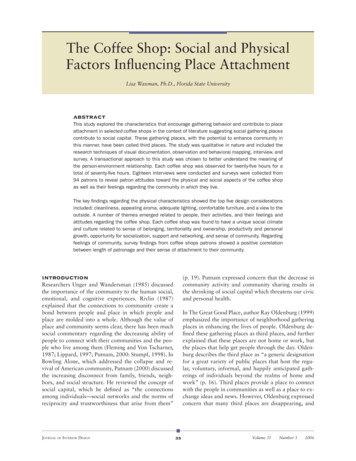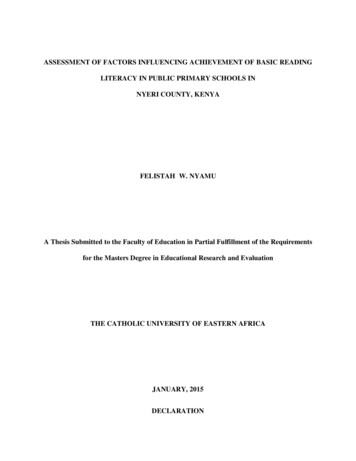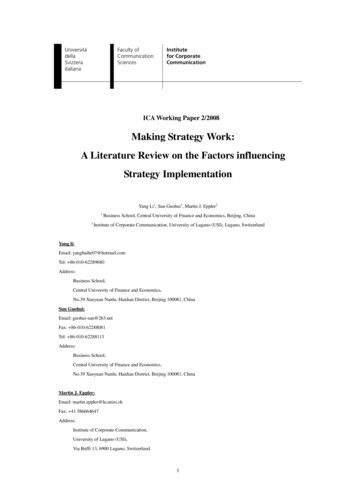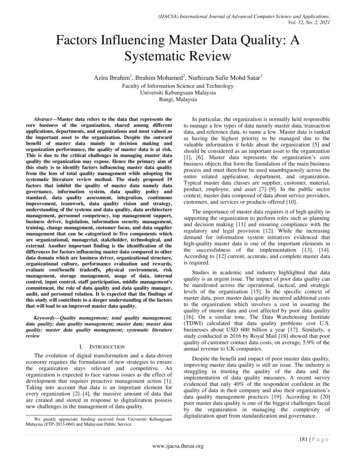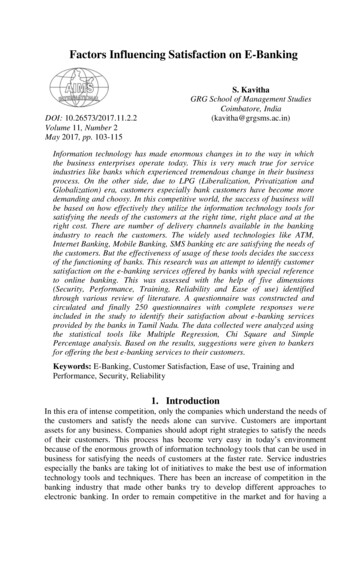
Transcription
Factors Influencing Satisfaction on E-BankingDOI: 10.26573/2017.11.2.2Volume 11, Number 2May 2017, pp. 103-115S. KavithaGRG School of Management StudiesCoimbatore, India(kavitha@grgsms.ac.in)Information technology has made enormous changes in to the way in whichthe business enterprises operate today. This is very much true for serviceindustries like banks which experienced tremendous change in their businessprocess. On the other side, due to LPG (Liberalization, Privatization andGlobalization) era, customers especially bank customers have become moredemanding and choosy. In this competitive world, the success of business willbe based on how effectively they utilize the information technology tools forsatisfying the needs of the customers at the right time, right place and at theright cost. There are number of delivery channels available in the bankingindustry to reach the customers. The widely used technologies like ATM,Internet Banking, Mobile Banking, SMS banking etc are satisfying the needs ofthe customers. But the effectiveness of usage of these tools decides the successof the functioning of banks. This research was an attempt to identify customersatisfaction on the e-banking services offered by banks with special referenceto online banking. This was assessed with the help of five dimensions(Security, Performance, Training, Reliability and Ease of use) identifiedthrough various review of literature. A questionnaire was constructed andcirculated and finally 250 questionnaires with complete responses wereincluded in the study to identify their satisfaction about e-banking servicesprovided by the banks in Tamil Nadu. The data collected were analyzed usingthe statistical tools like Multiple Regression, Chi Square and SimplePercentage analysis. Based on the results, suggestions were given to bankersfor offering the best e-banking services to their customers.Keywords: E-Banking, Customer Satisfaction, Ease of use, Training andPerformance, Security, Reliability1. IntroductionIn this era of intense competition, only the companies which understand the needs ofthe customers and satisfy the needs alone can survive. Customers are importantassets for any business. Companies should adopt right strategies to satisfy the needsof their customers. This process has become very easy in today‟s environmentbecause of the enormous growth of information technology tools that can be used inbusiness for satisfying the needs of customers at the faster rate. Service industriesespecially the banks are taking lot of initiatives to make the best use of informationtechnology tools and techniques. There has been an increase of competition in thebanking industry that made other banks try to develop different approaches toelectronic banking. In order to remain competitive in the market and for having a
104AIMS International Journal of Management 11(2)larger share in the market a company needs to have loyal customer base. Theseimportant issue prerequisites cannot be achieved except by earning their trust.(Akbari et.al. 2012). So high level of customer satisfaction will be essential for thesustainability of banks and this could be achieved when the customer satisfaction bynew upgraded services is measured and also the type of banking service that is ableto attract customers more than the other competes is recognized. Factors thatinfluence on adoption of various technologies and information technology aredifferent depending on the desired technology of studied users and the existingsituation. Customer satisfaction towards internet banking service has become anissue due to stiff competition among the banks in India. Customer satisfaction iscritically important for its impact on customer retention and firm profitability.Internet banking service quality and customer satisfaction are inarguably the twocore concepts for the researchers. It has been identified through various researchesthat quality of internet banking service is a key issue to maintain customersatisfaction. (Sharma et al., 2014). Even though many studies have been conductedto identify the customer satisfaction on e-banking, Tamil Nadu level study to analyzethe customer satisfaction on e-banking with the widely adopted dimensions, will helpthe bankers to formulate strategies for improving their quality of services on ebanking.2. Theoretical BackgroundE-banking or Internet Banking or online banking is a convenient way to do bankingfrom the comfort of any one‟s home or office. According to Oxford Dictionary ebanking is a method of banking in which the customer conducts transactionselectronically via the Internet. (Source: http:// www.oxforddictionaries.com/definition /English/e-banking). Users need not wait in a long queue in front ofcounters rather can do all the transactions from their convenient place. According toDaniel (1999), electronic banking is the delivery of banks „ information and servicesby banks to customers via different delivery platforms that can be used with differentterminal devices such as personal computer and mobile phone with browser ordesktop software, telephone or digital television. Electronic banking, therefore, couldbe categorized into PC banking, Internet banking, TV-based banking, and Telephonebased banking. The SBI Retail Internet Banking offers a plethora of products andservices, to cater to all the banking demands of the customers like Transfer funds toown and third party accounts, A suite of completely online deposit products (Fixed,Recurring, Flexi, Tax Saving etc.), Airline, Rail, Bus and hotel ticket booking,Online Shopping and instant recharge features, IMPS Funds Transfer, WesternUnion Service, Credit beneficiary accounts using RTGS/NEFT feature, Generateaccount statements, scheduling payments, Configure profile settings, E- Tax foronline tax payment, E - Pay for automatic bill payments etc., The Corporate InternetBanking (CINB) facility of SBI enables the corporate customer to carry out bankingactivities anywhere and anytime aided with the power and convenience of theinternet. According to ICICI web site, Internet Banking is a convenient way to dobanking from the comfort of the customers‟ home or office. They can avoid thequeue or delays by trying their simple and secure Internet Banking facility for anunmatched online banking experience. To experience the internet banking customershave to just login using their user id and password.
Kavitha105Customer Satisfaction (CS) has become a major area of marketing that hasreceived considerable publications from practitioners and scholars in the last twodecades. According to Kotler (2016), satisfaction reflects a person‟s judgment of aproduct‟s perceived performance in relationship to expectations. If performance fallsshort of expectations, the customer is disappointed. If it matches customerexpectations, they are satisfied and if it exceeds them the customer is delighted. Inshort satisfaction is a person„s feeling of pleasure or disappointment resulting fromcomparing a product„s performance (outcome) in relation to his or her expectation.Customer satisfaction can be defined as the overall customer evaluation of a productor service based on purchase and consumption experience over a time period. Thequality of services provided by the bankers in the banking sector plays important rolein the satisfaction of customer. The increase in customer satisfaction level leads todecrease in operating and service costs. This provides an opportunity for banks toexpand their product portfolio and services for the future development. (Sanyal,2016). Different researchers have attempted to measure the customer satisfaction one-banking services using different dimensions like Safety, Reliability, Transactionsefficiency, Customer support, Service Security, Ease of use, Performance, Accuracy,Timeliness, Confidence, Content, Format, Responsiveness etc.3. Literature ReviewThe customer user satisfaction concept was applied in the area of informationsystems in the early 1980s. Different authors have studied the concept of customersatisfaction on e-banking using different dimensions. Bailey and Pearson (1983)have developed a measuring instrument to analyze computer user satisfaction. Thisinstrument was adopted by researchers and practitioners for high validity andreliability. They also have identified 38 factors affecting user satisfaction anddeveloped a questionnaire using 7-point semantic differential scale of adjective pairs.Later Torkzadeh and Doll (1988) have modified the instrument from previous studiesand reduced the factors into five factors with 12 items. The final developed factorswere, content, accuracy, format, ease of use and timeliness. In 1991 they used theterm End User Computing Satisfaction as “the affective attitude towards a specificcomputer application by someone who interacts with the application directly”. Thismeans that the interaction could be towards any computer-based systems that hashuman-computer interaction.In 2004 Pikkarainen model is proposed by Pikkarainen and colleagues whichexamines the factors that influence the Internet use of services or goods. Theresearchers announced six effective factors on Internet transactions of goods andservices (usefulness, ease of use, Enjoyment, Providing information, security andconfidentiality, Internet connection quality.) This model was designed and tested foracceptance of electronic banking and the model is derived from the TechnologyAcceptance Model. (Davis.F.D. 2000)Salehi, Rostami, and Mogadam (2010) have studied computer user satisfaction toend user in AIS environment. They have used a modified version of Doll andTorkzadeh (1988) instrument and tested for its validity and reliability. This papervalidates accuracy, ease of use, timeliness, content, format, system speed and systemreliability. There were many attempts to simplify the factors and to suit it withstudies related to computer user satisfaction.
106AIMS International Journal of Management 11(2)Kumphar (2011) conducted a study on demographic profile of customers and itsrelationship with perception of service quality, service value and overall satisfactionin e-banking. The study showed that demographic characteristics like age, education,profession and income level are influencing perceived service quality, perceivedvalue and overall satisfaction in e-banking. So the author recommended the banks toadopt the right strategies as per the demographic profile of the customers.Gupta and Bansal (2012) tried to develop an instrument for measuring Internetbanking service quality in India and they also analyzed the impact of Internetbanking service quality dimensions on the overall Internet Banking Service Quality(IBSQ) and customer satisfaction. They developed a service quality scale of 22items. Using exploratory factor analysis they reduced the 22 items into fivedimensions: Security/Privacy, Reliability, Efficiency, Responsiveness, and SiteAesthetics. Model was further validated through Confirmatory Factor Analysis. Theycarried out a survey among the Internet banking users of Private, Public and Foreignbanks in Delhi. Multiple regression analysis revealed that security/Privacy dimensioncarries the maximum impact on the overall IBSQ whereas customer satisfaction ismostly affected by the Efficiency dimension as compared to other dimensions.Rangsan Nochai and Titida (2013) conducted a survey to examine the impact ofseven internet banking service quality dimensions on customer satisfaction usingmultinomial logistic regression analysis. A survey was done on customers of topthree banks in the Bangkok who use Internet Banking. Results showed that Safetyreliability, Transactions efficiency, Customer support, Service security, Ease of useand Performance have a significant impact on customer satisfaction.Sharma & Malviya (2014), conducted a study on Internet banking service qualityand its impact on Customer Satisfaction in Indore district. They developed a modelbased on service quality dimensions like ease of use, comfort, accessibility,confidence and responsiveness with the purpose to investigate the impact of servicequality on customer satisfaction. Through multiple regression analysis theyconcluded that all five dimensions were having impact on customer satisfaction.Ease of use, comfort and accessibility were the most important dimensions whichinfluence the customer satisfaction on e-banking.Table 1 Summary of Different Studies on E-Banking over Different Period and Factors as EBanking Service DimensionsAuthorBailey &PearsonTorkzadeh &DollPikkarainenModelSalehi, Rostami,MogadamYear1983198820042010Gupta & Banzal 2012Factors/DimensionsAccuracy, Reliability, Timeliness, Relevancy, Confidence in thesystem (like that 38 factors)Content, Accuracy, Format, Ease of Use andTimelinessUsefulness, Ease of use, Enjoyment, Providing information, Security,Confidentiality and Internet Connection qualityAccuracy, Ease of use, Timeliness, Content, Format, System speedand reliabilitySecurity/Privacy, Reliability, Efficiency, Responsiveness, SiteAestheticsSafety, Reliability, Transactions efficiency, Customer support, ServiceSecurity, Ease of use and PerformanceRangsan. Nochai2013and TitidaSharma &2014 Ease of Use, Responsiveness, Comfort, Accessibility, ConfidenceMalviya
Kavitha107Based on the above reviews, it was clear that different authors used differentdimensions to test the customer satisfaction on e-banking. From the above reviews,the five dimensions namely Security, Performance, Training, Reliability and Ease ofuse were selected to assess the customer/user satisfaction on e-banking. Thefollowing study was conducted to identify the relationship between differentdimensions of e-banking and the customer satisfaction on e-banking. The study alsotried to identify the relationship between demographic profile of the respondents andcustomer satisfaction on e-banking. (Kumphar 2011).4. Objectives To identify the relationship between e-banking dimensions and customersatisfaction on e-banking. To find the relationship between demographic profile of the respondents andcustomer satisfaction on e-banking.The broad research question is What are the dimensions affecting the customer satisfaction on e-banking?5. Research Model Proposed for the StudySecurityPerformanceTrainingCustomer SatisfactionReliabilityEase of useFigure 1 Relationship between Selected E-Banking Dimensions and Customer SatisfactionBased on the framework, the proposed hypotheses areH1: Security will have an impact on Customer Satisfaction on E-bankingH2: Performance will have an impact on Customer Satisfaction on E-BankingH3: Training will have an impact on Customer Satisfaction on E-BankingH4: Reliability will have an impact on Customer satisfaction on e-bankingH5: Ease of use will have an impact on Customer Satisfaction on E-BankingH6: Demographic profile of the respondents‟ will have an impact on customersatisfaction on e-banking.6. MethodologyDescriptive research design was used for the study. Both primary and secondary datawas collected. Structured questionnaire was used as a source of primary data andapart from this some relevant secondary information were obtained from newspapers, magazines, records, websites and books. The population of the study was thebank customers in Tamilnadu who uses e-banking/internet banking services.
108AIMS International Journal of Management 11(2)A pilot study was done by administering questionnaire on 50 respondents selectedat random. As per the pilot study, minor changes were made into the questionnairebefore carrying out the final data collection. The questionnaire was divided into twoparts. First part includes questions related to demographic profile of respondents andsecond part includes the respondents‟ opinion on e-banking in the service qualitydimensions like Security, Performance, Training, Reliability and Ease of use. Therespondents have given their opinion in a five point Likert Scale (5-Strongly Agree,4-Agree, 3 – Neutral, 2 – Disagree, 1 – Strongly Disagree). The population for thestudy was list of bank customers who use e-banking facilities in Tamilnadu. Thestudy was undertaken among both public and private sector bank customers, who useinternet banking facility. Data was collected from Individual customers of the publicand private sector banks who use internet banking services by logging into the banksonline banking website using the Use rid and password provided to them by the bankusing a desktop or a laptop. Samples were selected using non probability Snow-Ballsampling. 250 complete questionnaires collected from the respondents were includedfor analysis. The data collection was done during Nov 2013 – Mar 2014. Cronbach‟sAlpha Test of Reliability is applied to test whether the items pertaining to scale, eachitems were internally consistent and whether they can be used to measure theproposed phenomena e.g. e-Banking dimensions like Security, Performance,Training, Reliability and Ease of use. All the values were found to be more than 0.8.The data analysis like Simple percentage analysis, Multiple Regression and Chisquare analysis were carried out using SPSS. The demographic profile of therespondents was analyzed using simple percentage analysis. The hypotheses relatedto the impact of e-banking five dimensions selected for the study like Security,Performance, Training, Reliability and Ease of use on Customer Satisfaction wastested using Multiple Regression Analysis. The relationship between demographicprofile of the respondents and Customer Satisfaction was tested using Chi-squareanalysis. The results of the analysis were tabulated and interpreted as shown below.7. Analysis and Discussion7.1 Simple Percentage AnalysisThe respondents were asked about their demographic details like age, gender,education, computer knowledge, occupation, income and period of relationship withthe banks. The distribution of respondents on the basis of demographic profile wastabulated below.7.2 Multiple RegressionA regression is a statistical tool used to find out the relationship between two or morevariables. In simple regression, there will be only two variables; one variable iscaused by the behavior of other variable. The variable, which is causing the behaviorof other variable, is called independent variable, and the variable which is caused byother variable, is called dependent variable. When there are two or more independentvariables, which affect the behavior of one dependent variable such relationship iscalled multiple regression or linear regression. Linear regression estimates thecoefficients of the linear equation, involving one or more independent variables thatbest predict the value of dependent variable.
Kavitha109H1 – H5: Security, Performance, Training, Reliability and Ease of use will have animpact on customer satisfaction on e-banking.Table 2 Demographic Profile of the RespondentsS No Demographic variable1234567GroupNo. ofRespondents15136593010165851050101894541961850 2020-35Age(years)36-5051-65above 65MaleGenderFemaleHigher secondaryGraduationEducationPost GraduationProfessionalZeroBasicComputer KnowledgeDiplomaGraduatePost GraduateGovernment50EmployeePrivate 14010Below or -40,00010 40,00025less than 1 year361-3 years71Period of relationship withthe bank4-6 years37 6 years106Source: QuestionnairePercentage 1.647.24.010.014.428.414.842.4Model: Here customer satisfaction was taken as the dependent variable and the fivedimensions of e-banking were the independent variables. The OLS Regression modelwas used to determine the significance level of the variables for the customersatisfaction on e-banking.The basic model was as follows.
110AIMS International Journal of Management 11(2)Customer Satisfaction on e-banking α ß1* Security ß2* Performance ß3*Training ß4* Reliability ß5 * Ease of useThere α is constant and ßs are coefficients to estimate, and e is the error term.The overall regression model and its ANOVA were summarized as followsTable 3 Regression Model SummaryModelRR Square Adjusted R Square Std. Error of the Estimatea1.716.513.5032.64651a. Predictors: (Constant), Reliability, Training, Security, Performance, Ease of useTable 4 AnovaModel1Sum of Squares Df Mean 47.004FSig.51.328 .000aTotal3506.484249a. Predictors: (Constant), Reliability, Training, Security, Performance, Ease of useb. Dependent Variable: Level of SatisfactionThe ANOVA Test shows the p value - 0.000 which was less than 0.05, hence theresult was significant at 5% level of significance. It means there was a significantcorrelation between dependent variable and independent variables. Therefore,customer satisfaction level depends on different dimensions like Security,Performance, Training, Reliability and Ease of use. The overall predictability of themodel was shown in the Model summary above. The adjusted R square value of .503indicates that the model explains roughly about 50.3% of the variability in thedependent variable customer satisfaction on e-banking by the independent variablesSecurity, Performance, Training, Reliability and Ease of use. The remaining 49.7percent of the variation in customer satisfaction may be due to reasons not related toe-banking dimensions considered in the model.Table 5 CoefficientsModel1Unstandardized Coefficients Standardized CoefficientsTSig.BStd. Error(Constant)6.0711.713Security.221.042.3215.290 .000Performance.106.036.1602.923 .004Training.187.045.2104.172 .000Reliability.156.063.1662.472 .014.713.105.361a Dependent Variable: Level of Satisfaction6.786 .000Ease of useBeta3.543 .000Table 4 depicts significant F values which implies that the model and data werewell fit in explaining customer satisfaction in e-banking. Based on the data found in
Kavitha111the above Table, it could be interpreted that the independent variables such asSecurity, Performance, Training, Reliability and Ease of use have strong impact oncustomer satisfaction. The strongest relationship was between Ease of use andsatisfaction followed by Security and satisfaction and Training and satisfaction.The following Table shows the results of hypothesis testing.Table 6 Results of Hypothesis TestingH1Security and SatisfactionPResultValue.221 5.290 .000 Hypothesis 1 SupportedH2Performance and satisfaction.106 2.923 .004 Hypothesis 2 SupportedH3Training and satisfaction.187 4.172 .000 Hypothesis 3 SupportedH4Reliability and satisfaction.156 2.472 .014 Hypothesis 4 SupportedH5Ease of use and satisfaction.713 6.786 .000 Hypothesis 5 SupportedHypothesis Independent to Dependent Factor BetaFFrom the above findings the following regression model was formed: Customersatisfaction on e-banking 6.071 0.221* Security 0.106* Performance 0.187*Training 0.156 * Reliability 0.713 * Ease of UseFrom the above model it could be inferred that Ease of use was the dimensionwhich brings about major change in the customer satisfaction on e-banking followedby Security and Training. The last two dimensions were Reliability and Performance.Ease of use was the very important dimension which affects the satisfaction ofcustomers on e-banking. This result holds well with the results of different authors(Torkzadeh and Doll, 1988; Pikkarainen, 2004; Salehi, Rostami, Mogadam, 2010;Rangsan. Nochai and Titida, 2013; Sharma & Malviya, 2014). Other dimensions likeSecurity (Gupta and Banzal, 2012; Rangsan. Nochai and Titida ,2013), Performance(Rangsan. Nochai and Titida, 2013), Training (Rangsan. Nochai and Titida –Customer Support , 2013) and Reliability (Gupta and Banzal, 2012; Rangsan. Nochaiand Titida, 2013) also have some impact on the customer satisfaction on e-banking.The study identified that ease of use was very important e-banking dimension thataffect the customer satisfaction followed by security. So suggestion was given to thebanks that e-banking working should be made easy without compromising onsecurity at any cost since that was the second important dimension that affect thecustomer satisfaction on e-banking. Suggested changes include explaining andenforcing strong passwords, using the same code for temporary and permanentidentification, and using a consistent terminology throughout the user interface.(Morten et al., 2004). Banks should take necessary steps to offer the user friendly ebanking facilities with good security. They should do some research on identifyingthe best technology for combining Ease of use with Security.7.3 Chi-Square Analysis - Demographic Profile of the Respondents and Levelof SatisfactionIn order to assess the relationship between the demographic profile of therespondents like age, gender, education, computer knowledge, occupation, incomeand period of relationship with banks and the level of satisfaction of customers on ebanking a hypotheses was framed and tested using chi-square analysis.
112AIMS International Journal of Management 11(2)H6: Demographic profile of the respondents will have an impact on customersatisfaction on e-banking.Table 7 Results of Chi-Square Analysis – Demographic Profile and Level of SatisfactionS NoDemographic Variable1 AgeChi-Square Value P valueResult39.704.000 Significant2345GenderEducational QualificationComputer .000.000Not mePeriod of relationship with bank38.16251.956.000.000SignificantSignificantFrom the above chi-square analysis it is implied that the demographic profile likeAge, Educational qualification, Computer knowledge, Occupation, Income andPeriod of relationship with bank have a positive relationship with level ofsatisfaction of bank customers on e-banking but Gender was not having anyrelationship with level of satisfaction on e-Banking.Hence it can be concluded that the demographic profile of respondents like age,educational qualification, computer knowledge, occupation, income and period ofrelationship with bank are having a relationship with customer satisfaction on ebanking where as gender is not having any relationship with the same.Hence the banks should devise the right strategies to attract the different segmentof customers with different age group, educational qualification, computerknowledge, occupation, income and period of relationship with bank. Normally,young customers expect more service from e-banking since they are familiar with alllatest services. So, banks should enhance their services to their expectations at thesame time expectations of the elder customers also should not be ignored. Highlyeducated people will have the skill to operate with banking technology than thepeople with low education. Banks should consider this while designing e-bankingservices. Naturally people with good computer knowledge will feel it easy to workwith technology. The people in different professions and different income groupsmay have different needs and services from e-banking. Banks should develop their ebanking services according to the expectations of people in different occupation andincome range. (Kumphar, 2011). In this study, period of relationship with banks alsohas an impact on customer satisfaction. The customers with long term relationshipwill definitely have good customer satisfaction. Banks can utilize the e-bankingservices to retain the customers for long period. Banks should try to improve the ebanking services to attract the differentiated group of customers on the basis of age,income, education, computer knowledge, occupation, period of relationship withbank. They should design the e-banking services based on the needs of the differentsegments of people.8. Conclusion and LimitationsTo compete in this competitive marketplace and to sustain the competitiveadvantage, each and every organization has to adapt to the latest technologies, should
Kavitha113identify the modifications to the existing technology by conducting research. Thisresearch seeks to make an original contribution to knowledge by investigating theimpact of five e-banking dimensions like Security, Performance, Training,Reliability and Ease of use on Customer Satisfaction on e-banking. To introduce thesecurity in e-banking services, the banks can incorporate new technologies likeencrypting and verification. The security issues can be moderated through improvedauthenticating process, protecting password, information about site security, givingabsolute loss guarantee (if something goes wrong during transaction banks shouldcorrect the errors without much delay), providing accessible customer service(multiple channels like SMS, E-mail and Toll free numbers should be given forcustomers to file their complaints) and educating customers on features of e-banking.(Maryam, 2013). Most of the studies showed that if Ease of use and Security is high,customer satisfaction on e-banking will increase. This is proved in this study and thiswill also increase the loyalty of customers towards bank and it will create positiveWord of Mouth (WOM) in the context of e-banking services. The e-bankingdimensions and its impact on customer satisfaction identified through this study willallow bank managers and policy makers to direct their efforts and resources in mosteffective and efficient way through which bank business can increase in long run andnew customers can be encouraged to adopt and use e-banking. The study revealedthat demographic profile of the respondents like age, education, computerknowledge, occupation, income and period of relationship with the bank are havingrelationship with e-banking satisfaction. Hence banks should give importance tosegmenting their customers and offering products as per the needs of the segments.Adoption of e-banking by most of the customer
the customer satisfaction on e-banking with the widely adopted dimensions, will help the bankers to formulate strategies for improving their quality of services on e-banking. 2. Theoretical Background E-banking or Internet Banking or online banking is a convenient way to do banking from the comfort of any one‟s home or office.

